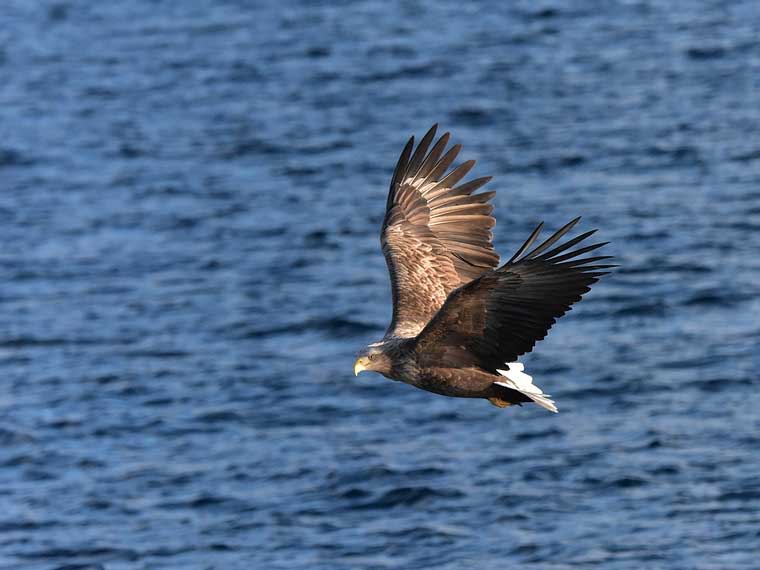Eagles have fascinated man for centuries. This apex predator combines grace and power whilst in the air, but what’s not so well known about them is how they behave in the water.
Whilst might be aware that eagles can pluck fish from the water, what would happen if they were to be in the water, needing to swim? Here’s all you need to know.
Can eagles swim? Eagles can swim short distances but are not proficient swimmers. It’s rare to see eagles swimming and will mostly occur whilst they hunt for fish. Their thick feathers mean they can float, they have a clumsy swimming style, and can drown if too far from shore.
Whether eagles can swim has been a common question among those researching and learning about eagles. Most people know that eagles can dive into the water for food, but they didn’t realize that they have a swimming ability too.
Even though eagles can swim, it is not something you are likely to witness, and if it is seen, it is almost always near a shoreline. I do have a video of it below though, so keep reading to see how they do it!
How eagles can swim
Eagles have large wingspans, and due to their superb flying abilities, they also have very powerful chest muscles. All things that lend themselves to being able to swim to some degree.
Eagles swim by using their wingtips to push down into the water, not to dissimilar to how a human would do the butterfly stroke.
Whilst eagles can swim to a degree, under certain circumstances, they will be at risk of drowning. Continue reading to discover all the reasons an eagle would be swimming, when it could be a cause for concern, and other impertinent facts about eagles near water.
But first, here’s that video I promised of a swimming eagle.
Why eagles would be in the water swimming?
Eagles are known for not wanting to fly over the sea or large open expanses of water. This makes their ability to swim even more surprising, but there are reasons why you might see them in the water in this way.
Eagles are not ever going to go on a casual swim in the water. Eagles prefer to be in dry surface areas whenever possible, only venturing over and into the water to hunt fish. If you are fortunate enough to see eagles swimming, there are typically two main reasons for it:
- Finding food.
- Getting stuck in the water trying to get food.
In other words, hunger and becoming waterlogged.
1. Swimming due to hunger
Eagles watch for fish near the surface of the water, and when the time is right, they dive in for the catch. However, sometimes eagles do not realize how large and heavy a fish may be compared to their body size, which results in not being able to pick up the fish and fly off.

If a fish is too large and the bird is near the shore, it may try to drag the fish back to the land through the water, or it may give up completely, regroup, and try again for a smaller fish dinner.
It’s common for them to get a hold of a fish that’s too heavy to fly with…they can’t take off but they can tow it to shore, rowing with their wings. They’re pretty good swimmers. They have thick down so they float pretty well. Occasionally they’ll drown if they’re too far from shore.
Spokesperson from the Alaska Department of Fish and Game.
2. Swimming but becoming waterlogged
When searching for dinner, an eagle can become waterlogged. Meaning its feathers are too heavy and weighed down with water that the eagle cannot gain momentum and fly out of the water.
When hunting for prey in the water, eagles try to stay as close to the surface as possible to keep their wings and feathers dry. If the eagle gets too submerged in water and its feathers become too heavy and saturated, the bird will try to swim back to shore to relieve water from the wings.
Waterlogging is a real risk quite frequently, and due to such, eagles have learned to hunt near land for quick escapes to safety if unable to fly out of the water.
The dangers of eagles swimming
While eagles can swim, they must be cautious when doing so. Eagles hunt near the shore or try to stay near other means of safety to be able to escape the water as quickly as possible.
If an eagle is in the water too long or too far from shore, its feathers can become overly saturated and heavy, causing the bird to drown. Eagles also risk hypothermia with prolonged exposure due to the drastic decrease in body temperature the eagle is not conditioned to withstand.
Handy Hint: There are not many animals above eagles in the food chain, but some will still eat them given half a chance!
Can eagles swim underwater?
Eagles cannot swim underwater. Eagles dive into the water to get food, but as soon as they grab the fish or after a failed attempt, they do not continue swimming underwater.
Their feathers retain moisture, and if they tried to swim underwater, they would not be able to take back off into the air. Eagles do best if only swimming in short bursts to prevent becoming waterlogged.
There have been reported sighting of eagles being dragged underwater by fish they have their talons in, but if it gets too deep and for too long, the eagle will release and come back to the surface.

Can all eagles swim?
Whether or not all eagles can swim is open to debate. For example, if you were to ask me whether harpy eagles can swim, I would assume perhaps not. I’ve not heard of any reported incidents of harpy eagles being seen swimming, plus they live in forest and jungle habitats.
On the other hand, golden eagles can probably swim due to the fact they are found in places such as the open moorlands and mountains of Scotland. They will never be too far away from lochs and coastline.
As you can probably imagine, sea eagles can swim due to their chosen habitat and daily routines. They will swim in a manner similar to how I outlined at the start of this article.
And lastly, whether crowned eagles can swim is probably open to debate too. I just don’t think the opportunity will present itself that often given their habitat and diet. However, if put in water, I suspect instinct would kick in, letting them swim to shore if close by.
Related questions
From now on, if you ever see an eagle swimming, you will know they were more than likely attempting to get food and failed that attempt.
Can eagles see in the dark to fish? Or does their diet consist of anything other than fish? There are many other questions to explore related to eagles near water.
How long can eagles swim?
How long they can swim has never been scientifically tested. Anecdotally thought, they have been swimming for 5 minutes from water to the coastline when dragging their prey back to land.
Can bald eagles take off from water?
Yes, eagles can take off from water, but there are some caveats with this. It will be possible for an eagle can take off from water’s surface but it’s providing they haven’t been into the water for too long. This is because their feathers get too wet meaning they are too heavy to take off.
Handy Hint: People often say that eagles look angry. There are good reasons why they do, as you will find out.
Can eagles drown when swimming?
Unfortunately, yes. Drowning while swimming goes back to the eagle becoming waterlogged, overly tired, and too far away from shore. If an eagle gets waterlogged too far from shore, it could drown from over-exhaustion or hypothermia.
Eagles are land animals, and water can plummet their core body temperature relatively quickly, so getting out of the water as fast as possible is necessary.
How deep can eagles dive into water?
Watching an eagle hunt in the water for its prey is truly a sight to be seen. They do not dive more than a foot into the water to catch the fish, though.
Many times, eagles will take dead or floating fish from the surface of the water before diving in much deeper. The gracefulness of the entire process, though, is really an honor to witness.
What percentage of an eagle’s diet is fish?
Fish is the primary food source for many eagles and is why you might see them in water. In roughly a 4-minute time frame, an eagle can consume an entire pound of fish. The sharp talons and beak of the eagle allow it to tear through its prey with ease.
The eagle’s diet contains an average of 75% to 90% fish, depending on its geographical location. Eagles located near largely populated water sources would consume more fish in their diet than those found in drier areas. Other than fish, eagles’ prey includes raccoons, rabbits, and other small mammals like squirrels.
Can eagles see in the dark?
Eagles have excellent vision. Humans with perfect vision can see an average of 5 feet away from them. Eagles, however, can see things from a distance of 20 feet away. That is over 4 times the human eye.
Despite this excellent daytime vision, their nighttime vision is not as good as humans. Eagles are diurnal animals, meaning they are active during the day and sleep or are dormant at night. So, while they can see somewhat at night, you will seldom see them actively hunting, flying, or swimming at night.
Conclusion
Eagles are symbols of beauty, grace, bravery, pride, determination, and honor. Being graced by the presence of an eagle is a humbling experience. We all know eagles are large birds, well known for being expert fliers, are skilled hunters, and are equipped with excellent eyesight.
But did you know that eagles can fly up to 30 mph, develop the white head and tail feathers by the age of 6, and that eagles can swim?
Well, now you do, but don’t expect to rush out and see it given how rare an occurrence it is.
You might also like…
- The diet of a bald eagle in winter will often involve roadkill!
- Tips for attracting bald eagles to nest in your own yard
- Why bald eagles have white heads and are not actually bald
Image in header via https://pixabay.com/photos/waters-bird-nature-outdoor-3251119/

